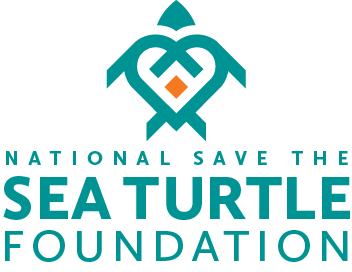The UCF Marine Turtle Research Group – A Whole-Life Approach to Understanding Sea Turtle Biology and Informing Conservation
Kate Mansfield, PhD, Associate Professor
Director, Marine Turtle Research Group
Department of Biology, University of Central Florida
Director, Marine Turtle Research Group
Department of Biology, University of Central Florida
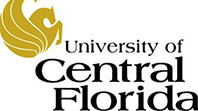
In 2013, I won the job lottery. At the time, I’d been working for both Florida International University and the National Oceanic and Atmospheric Administration’s (NOAA) Southeast Fisheries Science Center in Miami, Florida. I’d been writing grant after grant to support myself while working on exciting new satellite tracking techniques to finally track what was known as the ‘sea turtle lost years’—the early few years of a sea turtle’s life that is spent in the open ocean. It was about two to three years after the 2010 Deep Water Horizon oil spill in the Gulf of Mexico and I’d received funding to head offshore in the northern and eastern Gulf of Mexico to catch baby sea turtles, put small, solar-powered satellite tags on them using a combination of manicure acrylic, old wetsuit material, and aquarium silicone, and release them with oceanographic drifters (a fancy term for old PVC buckets with satellite tags and floats strapped to them). The data we received from these turtles, and others we’d tracked in the Atlantic was exciting—we were starting to better understand what baby turtles did during their first few years at sea, and we were turning old assumptions about these sea turtle “lost years” upside down with our new observations.
I’ve worked with sea turtles since 1994; by 2012-2013 I’d certainly heard of the UCF Marine Turtle Research Group and its founder, Doc Ehrhart. I’d taken Florida’s required Index Nesting Beach Survey trainings including one up near the Archie Carr National Wildlife Refuge, one of the UCF MTRG’s study sites back in the late 1990s. I remember heading out to the beach early in the morning to see examples of sea turtle crawls and learn the difference between what a nest looks like on the beach and a “false crawl” or non-nesting emergences. The beach was covered in fresh crawls—all highlighted in shadowy relief with the early morning sun. I’d not seen anything quite like it. At that time, I’d worked on beaches where six crawls in a night was considered a huge (and hectic) night—not 100s!
Fast-forward to 2013—I’d just been hired to take over the UCF MTRG; I’d “won” what I now consider the job lottery. The program was founded in the late 1970s by “Doc” Ehrhart. He’d originally trained as a small mammal biologist. But when he was a young professor at UCF conducting some of the environmental assessments for the new launch sites at Kennedy Space Center, he was asked by University of Florida’s Dr. Archie Carr, the preeminent sea turtle researcher at the time and now considered the grandfather of sea turtle research, to check out the beaches south of the Space Center for sea turtle nesting activity.
After founding the UCF Marine Turtle Research Group in the late 70s and early 80’s, Doc devoted decades to monitoring central and south Brevard County’s beaches from Patrick Air Force Base south to Sebastian Inlet State Park. These beaches, especially in the southern portion of the county, support some of the most active sea turtle nesting sites in the Western Hemisphere. Data from the UCF MTRG were used to help establish the Archie Carr National Wildlife Refuge (ACNWR) in southern Brevard County in 1991. This 20 km (~13 mile) stretch of beach now hosts 15-20% of all loggerhead, and about 33% of all green sea turtle nesting in the state of Florida, along with 20-50 leatherback nests each year. Twenty kilometers of beach—let that sink in. Yet these numbers weren’t always the case. Back in the 1980s, Doc and his crew were lucky to observe 40-50 green turtle nests along these beaches. But with the establishment of the ACNWR, the implementation of the Endangered Species Act and fisheries bycatch reduction policies, and local beachfront lighting ordinances, one turtle generation later, the lab and program I inherited is starting to see the conservation successes for which Doc’s and others’ early work laid the foundation.
In 2013, the lab was experiencing a record green turtle nesting year. I’d accepted the job as the new director of the UCF Marine Turtle Research Group and was to start that August. I made several trips up that spring and summer to get a feel for the program and its field sites. But I’d never experienced a nesting season quite like the one in 2013 (nor had my new lab). Green turtle nesting had exploded and the lab counted 11,000 green turtle nests that summer—a record. The first night I spent on the beach with what was to become my new crew, was incredible. I was visiting with a close friend and mentor from Brazil, Neca Marcovaldi. She is one of the founders of Brazil’s TAMAR—another long-term sea turtle research and conservation program. We walked out on the beach and turtles were emerging everywhere. We were trapped—when female turtles first emerge from the water to nest, they are easily spooked. We could barely walk 100 m without having to wait quietly, low on the beach while turtles emerged and crawled up the beach before we could continue on. After about an hour, we started to giggle and couldn’t stop. Neither of us had experienced anything quite like this beach and its turtles. What I later learned was that during the peak of nesting, the ACNWR beaches may have more turtles nesting in one night than most Florida nesting beaches see in an entire season. Conceptually, I’d known that it was a high density nesting beach, but until I’d spent a night, and now several summers, on the beach, “high density” was just a concept, not an experience.
Sea turtle research is “slow science”. Some species of sea turtle take upwards of 25-35 years to reach maturity. That’s 2-3 decades before they can reproduce and contribute to the growth of their population. After their first years in the open ocean as part of the sea turtle “lost years”, larger juvenile turtles recruit back to coastal waters where they may remain until maturity. These coastal waters include places like the Indian River Lagoon in Florida where Doc also started long-term in-water monitoring program. Twice a month, year-round, a crew of students, staff, and faculty take three boats and set a half-kilometer long tangle net just south of the Sebastian Inlet. The net soaks for 3 hours, and all turtles snagged in the net are immediately removed to a “work-up” boat where they are measured, weighed, and their health and diet are assessed through blood draws and tissue samples. About half of the juvenile green turtles caught in the IRL have a disease called fibropapillomatosis (FP). This disease results in large tumors found on the soft tissue of sea turtles infected with a virus thought to be associated with the disease.
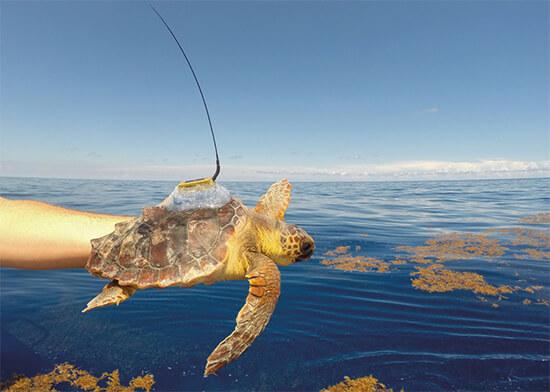 A juvenile loggerhead turtle carries a specialized transmitter to reveal its movements in the open ocean. Activity authorized under NMFS Permit #19508. Photo: K. Mansfield.
A juvenile loggerhead turtle carries a specialized transmitter to reveal its movements in the open ocean. Activity authorized under NMFS Permit #19508. Photo: K. Mansfield.Gustavo’s work will help us understand whether these numbers reflect broad genetic diversity or whether the thousands of turtles now found in our study areas are part of a genetically fragile group with little diversity stemming from those few but persistent turtles in the 1980s.
We continue to push the boundaries of our offshore “lost years” work. We have active research programs to tag and track baby turtles in the North and South Atlantic, and collaborations elsewhere in the world. We will also be testing newly developed, smaller solar GPS tags with more sensors that will allow us to better understand the behavior and movements of baby turtles during their first years at sea. In collaboration with the ICARUS Iniative, PhD student Katrina Phillips is determining the likely stock and rookery of origin among the wild-caught turtles we’ve satellite tagged in the Gulf of Mexico. She is using oceanographic models to determine how they arrived at their capture locations from their source rookeries. Alex Sacco, another PhD student will build on Katrina’s work using remotely sensed habitat data to better predict when baby sea turtles are found in Sargassum, a transient, floating brown algae that provides a warm, protected, and food-filled habitat for young ocean-going turtles.
That request changed the trajectory of Doc’s career (though there are hints of Doc’s past research training in the lab including old mouse bone preps and hints from old sea turtle datasheets.
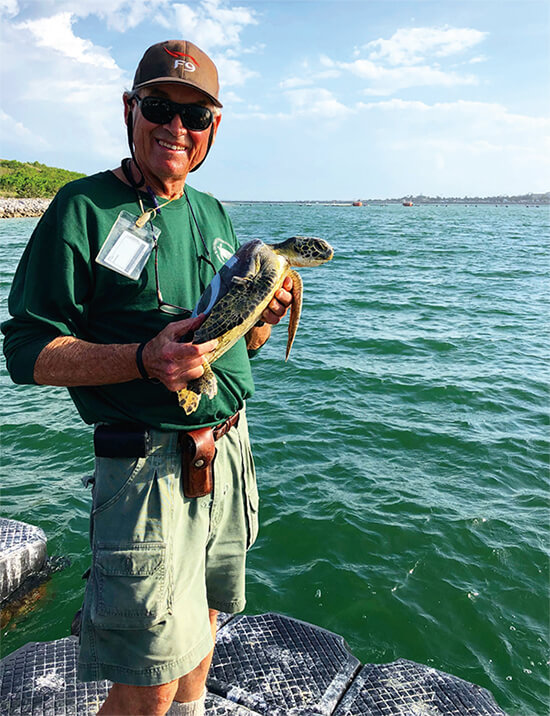
UCF Marine Turtle Research Group’s founder, Lew “Doc” Ehrhart with a juvenile green turtle. Activity authorized under FWC MTP-231 and NMFS 19508. Photo: K. Mansfield
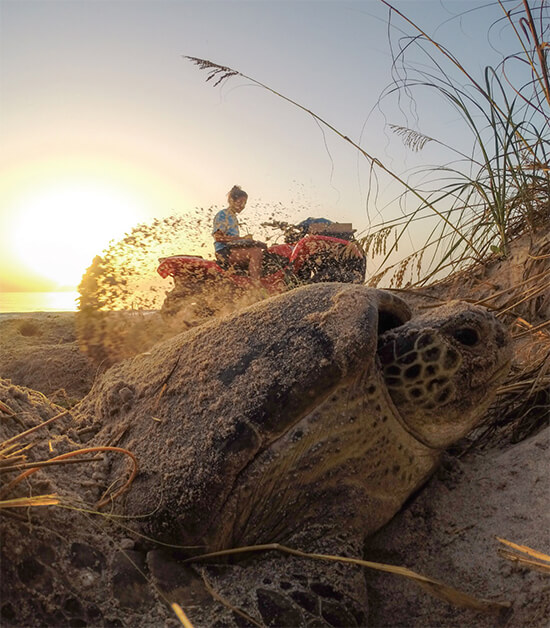 A green sea turtle nests in the Archie Carr National Wildlife Refuge. Florida’s Brevard County is one of the busiest sea turtle nesting beaches in the world. Activity authorized under FWC MTP-186. Photo: G. Stahelin
A green sea turtle nests in the Archie Carr National Wildlife Refuge. Florida’s Brevard County is one of the busiest sea turtle nesting beaches in the world. Activity authorized under FWC MTP-186. Photo: G. StahelinWhen I joined the UCF MTRG, I brought with me my research on the oceanic stage turtles. Combining this work with the long-term nesting beach and in-water programs established by Doc, the UCF MTRG is now able to tackle key conservation questions across the entire life cycle of sea turtles. With close to 40 years of research data from important nesting and coastal foraging habitats, including decades-worth of blood and tissue samples collected, we can start to answer questions about sea turtle health, population changes, and diet changes over time, as well as examine responses in all of these factors with changes in the environment. One of my PhD students, Chris Long, is studying the effects of Harmful Algal Blooms (HABs) in the IRL on green sea turtle catch rates and diet—green turtles are plant-eaters as adults, changing from a broad to specialized plant-based diet as juveniles in coastal habitats. Chris is documenting changes in green turtle diet before and after large-scale algal bloom events. Another PhD student, Gustavo Stahelin, is re-examining population genetics using new techniques to search for any changes in genetic make-up of adults and juvenile green turtles found at our study sites over the last couple of decades. Back in the 80s, there were only a handful of green turtles nesting in what is now the ACNWR. Every other season since 2013, we have had successive record-breaking green turtle nesting years with nest numbers that now exceed that of the loggerheads.
Sea turtle research is, by necessity, “collaborative science” given the time scales associated with these animals’ long lives as well as the geographic scale across which an individual may be found during its life. Doc Ehrhart’s work has allowed me to build on the decades of data he collected, and to think about sea turtle research in new, creative ways, across all stages of a sea turtle’s life. We have exciting new collaborations with disease experts including Dr. Anna Savage, another junior faculty member in the UCF Biology Department who specializes in disease ecology. We are jointly working with or advising students who are working on the FP problem, blood health parameters across all life stages, as well as a PhD student, Katie Martin, who will be looking at gene expression and developmental immune questions across all life stages, from eggs to adults. Finally, with the addition of sea turtle diet expert Dr. Erin Seney to the lab in 2014 as an Assistant Research Scientist and faculty, we have active diet and novel microbiome projects resulting in award-winning research by undergraduate students working with Dr. Seney.
A sea turtle generation roughly equals the span of one scientific career. This is why it is incredibly important to maintain and support long-term collection of data for sea turtles and other long-lived, late maturing species. Sea turtles are incredibly lucky that UCF had the foresight to continue Doc’s legacy and hire a successor to take the UCF MTRG into the next 30+ years and provide continuity to the research program started all those decades ago. I am incredibly lucky to have been hired as that successor. It is gratifying to know that data from this project helps to directly inform management agencies who in turn create policy to manage imperiled sea turtle species. More importantly, this lab has a strong legacy of providing hands-on research experience to early career scientists, including undergraduates and graduate students. Many of the alumni from this lab are now among the top sea turtle researchers or managers in this field. It is easy to understand how students are hooked by sea turtles. One of my favorite things is to observe our new undergraduate summer interns each May as they encounter and get data from their first nesting turtles on the ACNWR. And later as they see their first hatchlings. By the end of the summer, these interns are like a NASCAR pit crew, jumping in to take measurements, biopsies, and tag nesting females before moving on to the next turtle, and the next, and the next... The confidence they get from the program, as well as the experience of the ACNWR nesting beach and the joy of working with such ancient and interesting creatures is lasting and a pretty phenomenal legacy to instill.
Helping Sea Turtles Survive for 38 Years
A NON-PROFIT ORGANIZATION
State of Florida Registration Number CH-2841 | Internal Revenue Code 501 (c) (3)
Web Design & Development by Web Expressions, LLC
